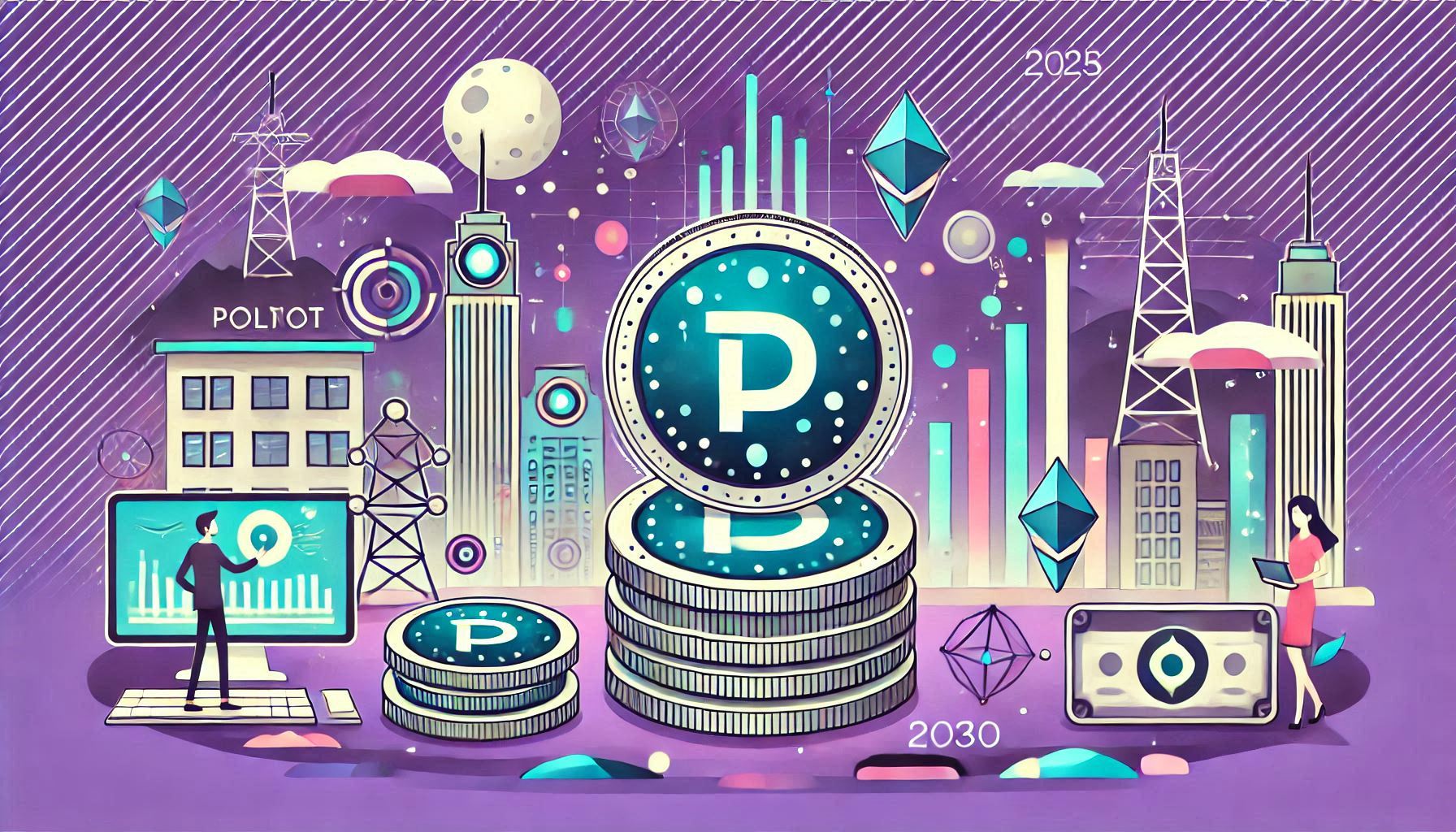Introduced by the co-founder of Ethereum, Polkadot is the first blockchain that is made modular. As such, it happens to be one of the most innovative cryptocurrencies out there, and with some major upgrades coming up, investors are eager to know: where really will DOT head next? This writing gives perspective on how each of the key factors could affect future evaluations of Polkadot’s price, as well as some valuation possibilities for the future as soon as 2025 to as late as 2030.
Overview
| Coin Name | Polkadot (DOT) |
| Polkadot Price | $6.67 |
| Polkadot ATH | $54.98 (November 4, 2021) |
| Polkadot Price Change (24h) | 0.70% |
| Volume (24hr) | $206.75M |
| Polkadot Market Cap | $10.22B |
| Circulating Supply | 1.53B |
Polkadot Price Prediction 2025
By 2025, DOT will be oscillating between $6.71 to $24.88 with an average of $15.15. The projected value means DOT will have an ROI of about 273.30% from current levels. This could be due to the increased utility of the network and investor interest.
| Month | Min. Price | Avg. Price | Max. Price |
| Jan 2025 | $ 6.71 | $ 8.75 | $ 10.74 |
| Feb 2025 | $ 9.93 | $ 14.34 | $ 19.22 |
| Mar 2025 | $ 15.66 | $ 17.64 | $ 19.22 |
| Apr 2025 | $ 15.61 | $ 18.95 | $ 21.28 |
| May 2025 | $ 11.21 | $ 16.87 | $ 22.17 |
| Jun 2025 | $ 9.22 | $ 11.81 | $ 14.34 |
| Jul 2025 | $ 7.89 | $ 9.20 | $ 10.19 |
| Aug 2025 | $ 10.15 | $ 12.70 | $ 14.87 |
| Sep 2025 | $ 14.53 | $ 16.22 | $ 18.21 |
| Oct 2025 | $ 14.97 | $ 18.93 | $ 21.36 |
| Nov 2025 | $ 17.36 | $ 21.40 | $ 24.88 |
| Dec 2025 | $ 13.26 | $ 15.01 | $ 18.53 |

Polkadot Price Prediction 2028
According to predictions for 2028, the projection would be a downtrend; DOT would settle at $6.10 by the end of the year. The coin will trade between $4.97 in November and $7.99 in March, with a potential ROI of 19.83%. Pretty decent, but the market is volatile, let alone the role that Polkadot holds within the blockchain space.
| Month | Minimum Price | Average Price | Maximum Price |
| January | $ 6.00 | $ 6.35 | $ 6.89 |
| February | $ 6.17 | $ 6.46 | $ 6.89 |
| March | $ 7.04 | $ 7.43 | $ 7.99 |
| April | $ 6.03 | $ 6.46 | $ 7.04 |
| May | $ 6.11 | $ 6.32 | $ 6.49 |
| June | $ 5.72 | $ 5.99 | $ 6.35 |
| July | $ 5.59 | $ 5.87 | $ 6.03 |
| August | $ 5.13 | $ 5.29 | $ 5.55 |
| September | $ 5.06 | $ 5.20 | $ 5.42 |
| October | $ 5.03 | $ 5.14 | $ 5.24 |
| November | $ 4.97 | $ 5.87 | $ 7.08 |
| December | $ 6.11 | $ 6.83 | $ 7.76 |
Polkadot Price Prediction 2030
Further down the line 2030 can be a growth year for Polkadot. Analysts expect the prices to range from $3.25 to $22.42 with a potential ROI of 236.13%. This is a very bullish prediction as Polkadot expands its ecosystem and solidifies its position in the decentralized space.
| Month | Minimum Price | Average Price | Maximum Price |
| January | $ 13.27 | $ 17.41 | $ 22.42 |
| February | $ 11.72 | $ 14.25 | $ 16.72 |
| March | $ 12.55 | $ 14.59 | $ 17.25 |
| April | $ 11.36 | $ 13.97 | $ 17.29 |
| May | $ 6.87 | $ 8.29 | $ 11.63 |
| June | $ 5.10 | $ 6.00 | $ 7.17 |
| July | $ 4.84 | $ 5.50 | $ 6.42 |
| August | $ 5.30 | $ 6.10 | $ 7.08 |
| September | $ 4.73 | $ 5.18 | $ 5.85 |
| October | $ 4.40 | $ 4.73 | $ 5.01 |
| November | $ 3.92 | $ 4.36 | $ 5.32 |
| December | $ 3.25 | $ 3.67 | $ 4.21 |

Price Drivers for Polkadot
There are many big factors driving DOT’s price:
1. Governance: This model of governance lets DOT owners directly vote on various network proposals. Staking interest rates, inflation as well as treasury funding conditions have impacts on the price at a long-term scale. Decisions by the council may still, however, introduce volatility through veto power in contentious cases.
2. Parachain Auctions: On this one, Polkadot only supports a fixed amount of parachains that have been distributed via auctions, where bidders had to lock up large amounts of DOT, which reduces the circulating supply. This type of auction will further increase demand as more projects try to get parachain status.
3. Staking Rates and Validator Performance: Staking on Polkadot is one of the security mechanisms in the network. This is rewarded to participants based on the staking rate and validator performance. The optimal staking rate on Polkadot is 60%. This means a big chunk of DOT is locked up hence reducing market sell pressure.
4. Ecosystem Development: The ecosystem growth of Polkadot has a positive effect on DOT demand. Technological advancements, partnerships, and project implementations within its ecosystem add value to token utility and, hence, market interest.
Conclusion
DOT is undoubtedly one of the most promising crypto assets due to its innovative blockchain approach and a very robust ecosystem. The crypto market is volatile, but unique governance, staking incentives, and developmental path make Polkadot strong in the long-term game.
As with all investments, one has to follow market trends, technology updates and general sentiment to make informed decisions on DOT.
Stay updated with Deythere as we’re available around the clock, providing you with updated information about the state of the crypto world.
FAQs
1. What is Polkadot and its associated significance?
It’s a multi-chain network that allows different blockchains to inter-operate with each other. It is highly valued because of its modular design, which accommodates parachain hosting. Hence, it stands as an important network in the blockchain.
2. How does governance apply in Polkadot?
Polkadot has a decentralized governance where DOT holders can propose and vote for changes. The council has veto power to prevent any ill choice.
3. What are parachain auctions and their significance?
Parachain auctions are the segment that defines which projects enter Polkadot’s bidding to secure a slot on its network. These auctions lock up DOT token,s which permanently ‘reduce’ the circulating supply and hence can affect the price of such tokens.
4. Can Polkadot reach $25 or more?
Reaching $25 is possible but depends on network adoption, ecosystem growth and broader market conditions. Analysts say significant upgrades and demand for parachains can drive future price increases.
5. Is Polkadot good for the long term?
Due to its innovative design, good dev team, and growing ecosystem, Polkadot is good for long-term investors. But market risks to be considered.
6. How does staking affect DOT price?
Staking locks up a big chunk of DOT tokens, reducing sell pressure and stabilizing the price. Rewards from staking encourage participants to hold their tokens.
7. What are the challenges Polkadot may face?
Other blockchain networks, governance debates and market volatility are some of the challenges. But its unique features put Polkadot ahead in the crypto space.
8. Where does Polkadot apply?
Interoperability and scalability make Polkadot applicable in finance, gaming, supply chain and decentralized apps.



















































































































